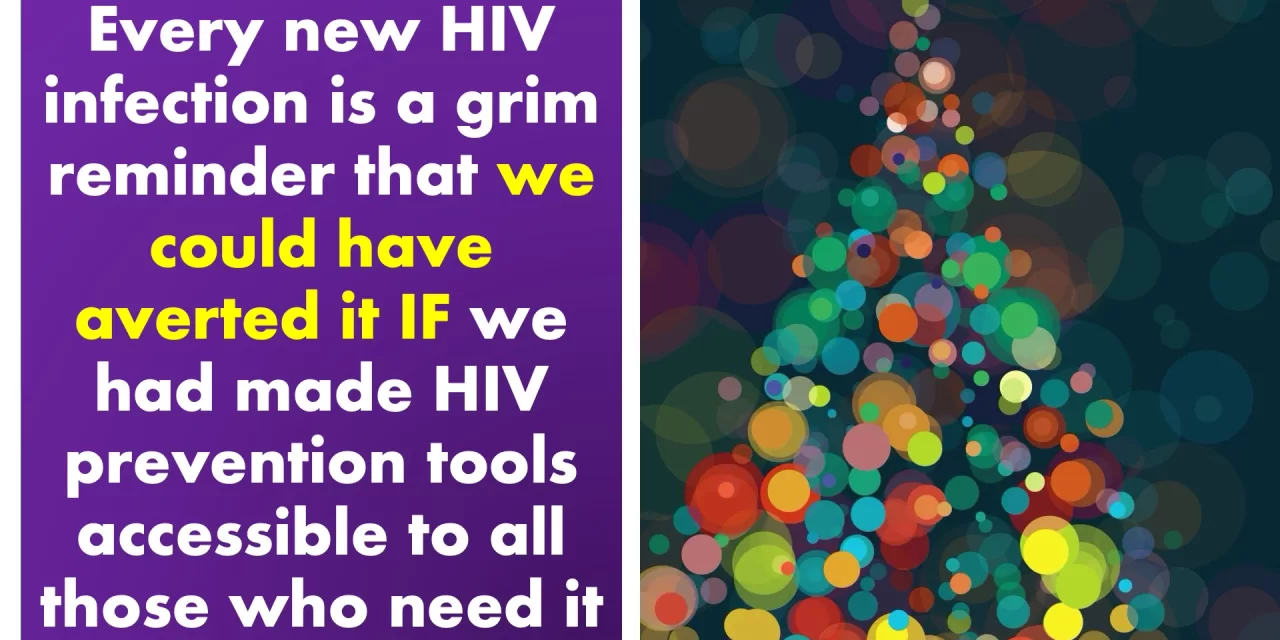Imagine failing 1.3 million times in a year: Failure to ensure that everyone has access to prevention options to protect oneself from HIV acquisition, has resulted in at least 1.3 million new HIV infections in 2023. The pace of progress towards ending AIDS is out of step if we are to end AIDS by 2030.
Scientific research has thankfully added new HIV prevention tools over the years. The range of options to protect one from HIV is expanding. But the growing range of HIV prevention options has failed to translate into more choices for people. We need to deliver new HIV prevention tools with speed, scale and equity, rightly says Mitchell Warren, Executive Director of AVAC.
“It is so wonderful to see a product do so well in clinical studies, but we have to remember too that this is not the first time we have seen an amazing prevention product (lenacapavir),” he said.
Lenacapavir is an antiretroviral medicine that is taken as Pre-Exposure Prophylaxis (PrEP) which reduces one’s risk of getting infected with HIV to zero or almost zero (one injection every six months). The study (PURPOSE-1) showed 100% protection for women and girls in June this year. Later, another study (PURPOSE-2) showed that lenacapavir reduced HIV infections by 96% compared to background HIV incidence among transgender men, transgender women and gender non-binary people. There were 2 incident cases among 2,180 participants, corresponding to 99.9% of participants not acquiring HIV infection in the lenacapavir group.
“These studies are spectacular but clinical studies do not prevent infections by themselves. We have to ensure these translate into real choices for people with equity and rights,” said Warren.
In July 2024 there was a global outrage when lenacapavir’s price was cited to be over US$ 40,000 per person per year. At such an astronomical price, a prevention option that is almost 100% effective in protecting people from HIV would be 0% used among those who need it most.
Owing to mounting pressure worldwide, makers of lenacapavir announced that six generic companies will be given voluntary licenses to make it at a much cheaper price to make it more affordable in 120 countries.
But why is lenacapavir not being made available at affordable prices to all nations worldwide? Countries whose people participated in its studies, such as Peru, Argentina, Brazil and Mexico, are also being left out.
Prices of HIV antiretroviral medicines came down when sale volumes went up and multiple generic manufacturers were competing to get the market.
Price of Cabotegravir (another antiretroviral medicine which is used as an injectable PrEP (intramuscular injection either once a month or once every three months) is more than US$ 20,000 a year in the US but its makers sell it ~US$ 180 a year in low- and middle-income countries.
Along with calling for scaling up generic manufacturing of HIV prevention tools with speed and equity, we also need to ensure these become accessible to people with equity and rights, says Mitchell. This will also help bring down the price and translate into more public health impact in terms of new HIV infections prevented.
“Lenacapavir is an injectable so it has to be in the health system, and not everyone is going to feel comfortable with that. We have to stay focused on larger prevention programming,” rightly points out Warren. “We need to work with a speed much faster, at a scale much larger, and with equity so that everybody can benefit from the full range of HIV prevention options we have today,” he said.
HIV prevention products will work only when we take them!
“Products work when you take them. With injectable HIV prevention options, you get a pretty great sense of their ability to overcome issues like adherence,” said Mitchell Warren. Earlier studies have shown that self-reported adherence to HIV prevention pills among study participants was variable (that is, some did not use the product under research), which impacted research study outcomes. Safe and effective pills or injectables will work only when people will take them. These will not work sitting on the shelf or people not able to access them or use them.
“HIV prevention products do not deliver by themselves. Work ahead (to deliver them to all people) frankly is as hard as product research and development. We have to translate efficacy of these products in clinical studies into effectiveness in people’s lives – this work is proving to be far harder,” said Warren, who was also part of the organising team of Conference on HIV Research For Prevention of International AIDS Society in Lima, Peru (where CNS is an official media partner).
Inequity within and between nations
Mitchell Warren points out at inequities not only exist between the Global North and Global South but also within the Global North nations.
“If you look at the United States which has had oral PrEP since 2012 (when it was first approved by US FDA, it is having an impact for typically white older gay men and other men who have sex with men often in the northern part of the US, whereas black and brown young men, particularly in the southern parts of the US, or women who may be at risk of HIV struggle with inequitable access to it for a whole number of reasons. It is a structural barrier too,” he said.
“Those who cannot remember the past are condemned to repeat it”
This oft-quoted verse sums up the exacerbating inequities in the roll-out of new health technologies.
“I think one of the things that I am continually struck by is that with every innovation in biomedicine we tend to see it exacerbating inequity,” he said and shared the example of grossly inequitable and unjust rollout of COVID-19 vaccines.
“We do not need any more examples of inequity, we need to flip the script,” rightly said the AVAC leader. “We need to do HIV prevention differently by showing as a global community that we can go beyond inequity”.
“There can be no excuses, no delays, and no repeats of the failures of oral PrEP rollout. We must move with speed, scale, and equity to ensure lenacapavir has the impact we need to prevent new HIV infections,” said Warren.
Global HIV Prevention Roadmap is there but the journey is ours!
AVAC-led inclusive processes have resulted in a Global HIV Prevention Roadmap for equitable expansion and delivery of services to HIV key populations.
“The good news is that there is a Global HIV Prevention Roadmap now. We do know how-to-do things differently. If you compare oral PrEP roll-out with injectable cabotegravir PrEP, the world still went too slow but it did go a little faster too with regulatory approvals. It went a little faster with programmes – not fast enough but faster comparatively. I hope with lenacapavir, we do it even faster,” says Mitchell.
There is no one magic solution for ideal rollout of HIV prevention technologies.
“There is no one solution that is going to make a product accessible for everyone. It is multifactorial – so just like we need condoms, dapivirine vaginal ring, cabatagravir PrEP, lenacapavir PrEP, and all other products which are in the full cascade of combination prevention options – we also need to recognise the rollout would also be multifactorial. It is not just about voluntary licenses, generic manufacturing, governments deciding to introduce it or other necessary steps, it is all of those steps! And the Global HIV Prevention Roadmap is there!” said Mitchell.
A map may at best tell us how-to-get to the destination, but the journey is ours. Likewise, with the global roadmap.
“While we are hoping for newer HIV prevention tools like a safe and effective HIV vaccine in future, we are not able to deliver the new HIV prevention tools we already have,” rightly points out Warren.
If we could rollout all the HIV prevention tools we have today to all those who need it globally – with equity and rights, then we would also chart a course to help do the same (or even better) when other safe and effective tools become available (like an HIV vaccine).
Communities too need to help create demand.
Combination prevention remains mainstay
There is no one HIV prevention option that may suit everyone. That is why, experts call for making all HIV prevention options (often referred to as combination prevention) accessible to everyone – and let people have a choice to access them with equity and rights.
According to UNAIDS, a combination approach to HIV prevention that includes behavioural, biomedical and structural approaches and is tailored to those in greatest need can lead to steep reductions in HIV infections. Combination prevention is a set of strategically-selected interventions that matches the needs of a given country or community—and is delivered at the scale needed to make an impact. It means doing less of something and far more of others. It means making tough decisions and measuring impact, says AVAC.
Make prevention famous!
“People often say make PrEP or condom or other HIV prevention options famous (to generate demand and increase its uptake) – but I would argue that we have to make prevention famous – which includes the full range of combination prevention. None of the HIV prevention options will disappear because we have a new one,” said Mitchell.
Every new HIV prevention method expands the range of options we have, to prevent HIV transmission – and if this menu of choices is made accessible to everyone – then it will help increase the uptake of one or more options – and would translate into reduction of new HIV infections. “We have to help people navigate these choices.”
Shobha Shukla – CNS (Citizen News Service)












